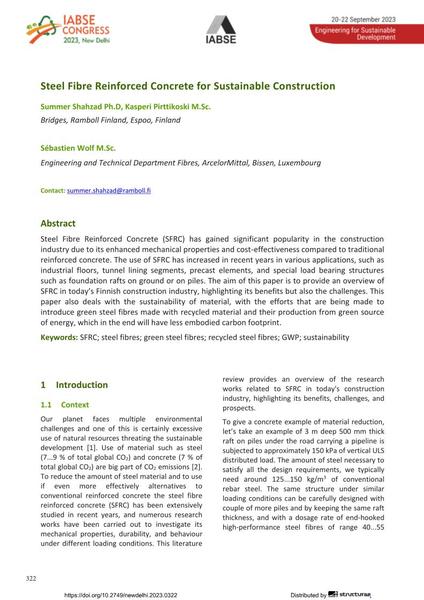Steel Fibre Reinforced Concrete for Sustainable Construction

|
|
|||||||||||
Détails bibliographiques
| Auteur(s): |
Summer Shahzad
(Bridges, Ramboll Finland, Espoo, Finland)
Kasperi Pirttikoski (Bridges, Ramboll Finland, Espoo, Finland) Sebastien Wolf (Engineering and Technical Department Fibres, ArcelorMittal, Bissen, Luxembourg) |
||||
|---|---|---|---|---|---|
| Médium: | papier de conférence | ||||
| Langue(s): | anglais | ||||
| Conférence: | IABSE Congress: Engineering for Sustainable Development, New Delhi, India, 20-22 September 2023 | ||||
| Publié dans: | IABSE Congress New Delhi 2023 | ||||
|
|||||
| Page(s): | 322-329 | ||||
| Nombre total de pages (du PDF): | 8 | ||||
| DOI: | 10.2749/newdelhi.2023.0322 | ||||
| Abstrait: |
Steel Fibre Reinforced Concrete (SFRC) has gained significant popularity in the construction industry due to its enhanced mechanical properties and cost-effectiveness compared to traditional reinforced concrete. The use of SFRC has increased in recent years in various applications, such as industrial floors, tunnel lining segments, precast elements, and special load bearing structures such as foundation rafts on ground or on piles. The aim of this paper is to provide an overview of SFRC in today’s Finnish construction industry, highlighting its benefits but also the challenges. This paper also deals with the sustainability of material, with the efforts that are being made to introduce green steel fibres made with recycled material and their production from green source of energy, which in the end will have less embodied carbon footprint. |
||||
| Mots-clé: |
durabilité
|
||||
